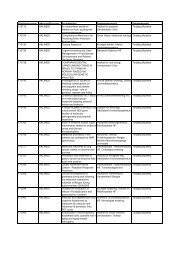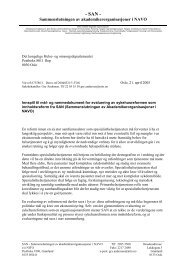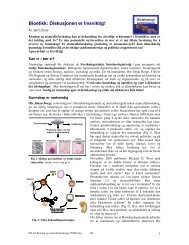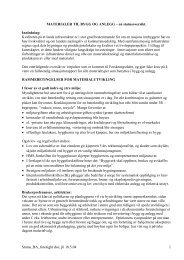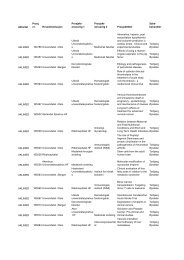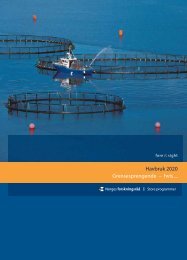A Revolution in R&D
A Revolution in R&D
A Revolution in R&D
Create successful ePaper yourself
Turn your PDF publications into a flip-book with our unique Google optimized e-Paper software.
46<br />
INDUSTRY CHANGES<br />
The genomics landscape features many small startups<br />
amid the larger genomics companies and the<br />
genomics divisions of big pharmaceutical corporations.<br />
But that landscape is chang<strong>in</strong>g. The number<br />
of deals—of genomics companies comb<strong>in</strong><strong>in</strong>g with<br />
each other or be<strong>in</strong>g taken over by big pharmaceutical<br />
firms—has been grow<strong>in</strong>g steadily. What is driv<strong>in</strong>g<br />
this tendency toward consolidation?<br />
The Pressure to Extend Scope<br />
Increas<strong>in</strong>gly, genomics companies are aspir<strong>in</strong>g to<br />
become full-fledged drug companies. No specialized<br />
company, it seems, has yet succeeded <strong>in</strong> build<strong>in</strong>g a<br />
truly stable competitive position as a drug-<strong>in</strong>dustry<br />
supplier; <strong>in</strong>tellectual-property statutes do not<br />
appear to be enough to guarantee long-term protection;<br />
and the chances of proprietary advantage are<br />
be<strong>in</strong>g nullified by the trend toward public-private<br />
partnerships or consortia, underwritten by big pharmaceutical<br />
companies.<br />
Wall Street appears to place a far higher value on<br />
<strong>in</strong>tegrated drug producers than on pure technology<br />
companies (if only because the drug sector has traditionally<br />
enjoyed such high profits and such high<br />
regard among <strong>in</strong>vestors). Accord<strong>in</strong>g to a recent USB<br />
Warburg study, the average <strong>in</strong>tegrated drug company<br />
has been able to raise $870 million, as aga<strong>in</strong>st<br />
a mere $330 million for the average technology<br />
company. (The study noted a further <strong>in</strong>terest<strong>in</strong>g<br />
divergence among technology companies themselves:<br />
biology companies—those focused on target<br />
identification and validation—raised $480 million<br />
on average, whereas companies <strong>in</strong> the chemistry<br />
area—those focused on screen<strong>in</strong>g and lead optimization—raised<br />
on average only $170 million.)<br />
In keep<strong>in</strong>g with this expansionist aspiration, most of<br />
the recent deals have consisted of acquisitions of<br />
downstream drug-development capabilities. Witness<br />
LION’s acquisition of Trega (for $35 million),<br />
Celera’s acquisition of AxyS (for $173 million), and<br />
Lexicon’s acquisition of Coelacanth (for $32 million).<br />
The Pressure to Achieve Scale<br />
As sections of the value cha<strong>in</strong> have become <strong>in</strong>dustrialized,<br />
the value of scale <strong>in</strong> R&D has ga<strong>in</strong>ed<br />
prom<strong>in</strong>ence. And for genomics platform companies<br />
and pharmaceutical companies alike, it may appear<br />
quicker and neater to achieve scale through a merger<br />
than through pa<strong>in</strong>stak<strong>in</strong>g <strong>in</strong>-house upscal<strong>in</strong>g. (Of<br />
course, pharmaceutical companies might have other<br />
reasons to acquire genomics companies: to jumpstart<br />
their genomics efforts, for <strong>in</strong>stance, or to<br />
acquire otherwise rare capabilities.)<br />
Sure enough, most of the recent mergers and acquisitions<br />
have clearly been <strong>in</strong>itiated for the sake of<br />
<strong>in</strong>creas<strong>in</strong>g scale: Sequenom’s acquisition of Gem<strong>in</strong>i<br />
Genomics (for $238 million), for example, or<br />
Sangamo’s acquisition of Gendaq (for $40 million).<br />
These scale deals have been primarily <strong>in</strong> target identification<br />
and validation rather than <strong>in</strong> chemistry—a<br />
reflection of the urgency of the land grab.<br />
The Pressure to Spend<br />
Whatever the <strong>in</strong>ducements to merge, there is a traditional<br />
impediment—lack of wherewithal. The spirit<br />
is will<strong>in</strong>g but the purse is weak. That is certa<strong>in</strong>ly not<br />
a constra<strong>in</strong>t, however, on some of the large<br />
genomics companies at the moment. In mid-2001,<br />
three top companies—Human Genome Sciences,<br />
Celera, and Millennium—boasted over $4 billion <strong>in</strong><br />
cash between them, represent<strong>in</strong>g about 25 percent<br />
of their comb<strong>in</strong>ed market capitalizations. Idle money<br />
cries out to be spent—probably, for these companies,<br />
on diversification more than on scal<strong>in</strong>g.<br />
Market expectations, a sense of urgency, an abundance<br />
of funds: all signs po<strong>in</strong>t<strong>in</strong>g to cont<strong>in</strong>ued consolidation<br />
<strong>in</strong> the near term.



